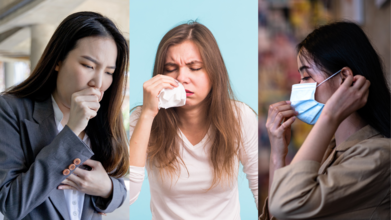- Health Conditions A-Z
- Health & Wellness
- Nutrition
- Fitness
- Health News
- Ayurveda
- Videos
- Medicine A-Z
- Parenting
- Web Stories
Diabetes Medication Millions Take May Be An Unexpected Protection From Blood Cancer

Credits: Canva
In an breakthrough scientific discovery, scientists have found that a common diabetes medication taken by millions globally—metformin, may provide unexpected protection against acute myeloid leukemia (AML), a fast-growing and frequently fatal type of blood cancer. This has been established by a new study by the University of Cambridge, which has been published in the highly-respected journal Nature. The study suggests metformin to be a low-cost, safe preventative therapy for individuals who are at high risk of developing AML.
This finding may represent a paradigm change in the approach to cancer prevention in medicine—particularly in hematological malignancies where early intervention is usually restrictive.
In contrast to solid cancers like breast or prostate cancer, which at times may be removed surgically, blood cancers are more difficult to localize and destroy. As Cambridge Stem Cell Institute Professor George Vassiliou describes it, "With blood cancers, we must first find people at risk and then apply medical treatments to halt cancer growth across the body." AML, which begins in the bone marrow and develops quickly, is an example of this difficulty.
Approximately 3,100 individuals in the UK are diagnosed with AML every year. It has a poor prognosis and few treatment options, especially in the elderly. Although the latest advances in blood testing are able to indicate individuals at risk years earlier than before, to date, there has not been a sure way to stop AML from forming.
How Diabetes Drug Interrupts Cancer Development at the Cellular Level?
Scientists targeted their research on DNMT3A, a gene commonly mutated in AML patients. This one mutation is thought to trigger as much as 15% of all AML. Metformin seems to break the energy metabolism of these pre-leukemic cells, targeting their aberrant growth pathways. By disabling the cells' capacity to produce energy, metformin stops them from developing into full-blown leukemia.
Additional analysis of health information from more than 412,000 UK Biobank participants reinforced the link. Metformin users had a significantly lower incidence of damaging mutations in the DNMT3A gene, whether or not they had diabetes. The results indicate a protective effect that is independent of the drug's initial purpose.
What is Metformi?
The origins of metformin trace back to medicinal plants used during medieval Europe. Isolated from Galega officinalis, a plant used in traditional medicine to cure urinary and metabolic problems, its active ingredient—guanidine—was discovered to lower blood sugar in the early 20th century. Although it was disfavored for a period, metformin was re-released and approved in Europe in the 1950s and subsequently by the FDA in 1995. It's now most commonly prescribed diabetes medication globally, especially in patients who have type 2 diabetes and are unable to regulate blood sugar levels by diet and exercise alone.
How Metformin Works?
Decreasing the level of glucose absorbed by the intestines through food.
Suppressing the liver's release of glucose.
Increasing insulin sensitivity, so that the body can utilize glucose more effectively.
These metabolic actions are not only helpful for controlling diabetes, but potentially for stopping or slowing other disease processes—such as cancer.
Benefits of Metformin
What's even more amazing is how metformin's benefits go beyond controlling blood sugar. According to Harvard Health and other medical centers, the medication has been linked with:
- Reduced cardiovascular mortality among diabetics
- Moderate weight loss
- Decreased risk for type 2 diabetes in persons with prediabetes
- Help with polycystic ovary syndrome (PCOS)
- Lower risk for cancers such as breast, colon, and prostate
- Possible diminishment of risk for dementia and stroke
Off-label prescriptions have also been used for some of these indications in metformin, highlighting the drug's versatile utility and solid safety profile.
One of the main advantages of metformin is its long history of safety. Taken by millions of people over many decades, it tends to have only minor side effects—e.g., nausea, bloating, or altered taste. Serious side effects, such as lactic acidosis, are infrequent and typically only occur in those with existing kidney disease.
As Blood Cancer UK's Director of Research Dr. Rubina Ahmed put it, "Repurposing existing, safe drugs such as metformin allows the possibility that new treatments might get to people earlier, without going through the extensive drug development pathways."
3-Day Mindfulness Challenge: Recharge Without Stepping Out This Long Weekend

Credits: Canva
If your idea of a long weekend usually involves binge-watching a drama series, mindless scrolling, and wondering why you are still in pyjamas at 4 pm, you are not alone. But what if you could come out of these three days feeling lighter, calmer, and maybe even more alive, without leaving your home? From Independence Day to Krishna Janmashtami on 16 August, followed by your favourite Sunday, take some time out for yourself and prioritise your wellbeing. This 3-day mindfulness challenge might open doors to great things, because when you destress and relax, you give space to creativity and better imagination.
Take up this 3-day mindfulness challenge and you do not need a passport; just you, your space, and a few intentional choices.
Why mindfulness, and why now?
We live life like we are running late for a bus we never actually catch, juggling to-do lists, work deadlines, and the background hum of anxiety. Dr Narendra K. Shetty, a consultant in mindfulness practices, puts it plainly:
“In our daily life we are running behind distractions and never-ending to-do lists… practising mindfulness helps us to overcome stress and find mental peace.”
Mindfulness, he explains, is “the basic human ability to be fully present, aware of where we are and what we are doing, and not overly reactive or overwhelmed by what is going on around us.”
And if you are wondering whether it is just another buzzword, science says otherwise. Research links mindfulness to reduced stress, better immunity, sharper brain function, and even healthier eating habits.
Day 1: Wake up, breathe, repeat
Before you check your phone, spend a few moments acknowledging that you woke up today. That simple gratitude shifts your brain chemistry towards positivity.
Nidhi Nahata, lifestyle coach, suggests beginning with “the smallest choices”, a glass of water sipped slowly, feeling it cleanse you from within, or opening your windows to let fresh air remind you of the world’s kindness.
From there:
- Mindful waking — Sit up in bed, notice how your body feels, and stretch like you mean it.
- Balcony breathing — Inhale deeply for four counts, exhale for six. Let your mind follow your breath.
- Nature gaze — Even if your view is just potted plants, watch them for a few minutes. Nature doesn’t rush — maybe neither should you.
Day 2: Move, eat, and live like you mean it
You do not need a gym session; mindful walking around your home counts. Feel your feet connect with the floor, notice your weight shift, and hear the subtle sounds you usually tune out.
When it comes to food, both experts agree: mindful eating is a game changer. Dr Shetty recommends a “colourful platter” because the more variety you see, the more nutrients you get. Nidhi suggests choosing food that is “alive”, fresh fruits, crisp salads, and meals planned ahead so you are nourishing, not neglecting, yourself.
Try this:
- Eat one meal without screens. Chew slowly, taste each bite, and notice textures.
- Take a digital detox for an hour — or, if you are brave, half a day.
- Ground yourself while walking barefoot on a safe surface, noticing each sensation.
Day 3: Clear the clutter — inside and out
Your surroundings affect your mental state more than you think. Nidhi suggests tending to your home “as you would to a loved one with care, with presence… clear spaces not just of dust, but of stagnant energy that weighs you down.”
This is also the perfect day to reconnect with people, not just your family and friends, but those who are part of your everyday rhythm. Ask your security guard how his morning was, or thank the delivery person. Listen without rushing. As Nidhi says, “In those stories, you will find a mirror of humanity — raw, real, and unfiltered.”
Dr Shetty’s advice here is simple but powerful: take five minutes every hour to check in with yourself. “Spend it on yourself to have a better life in the future,” he says. That could be stretching, sipping tea in silence, or simply breathing with awareness.
The magic isn’t in the grand gestures
Mindfulness is not about sitting cross-legged for hours while incense burns. It is about micro-moments of awareness sprinkled through your day. It is pausing before reacting to an annoying email, feeling the sun on your skin when you hang laundry, or laughing wholeheartedly at a silly joke.
As Nidhi reminds us, “Mindfulness is not a skill to master; it is the way life was always meant to be. Somewhere, in the rush of doing, we forgot how to simply be.”
Your 3-day cheat sheet
- Morning: Gratitude → Breathwork → Screen-free breakfast
- Afternoon: Mindful movement → Colourful, fresh meal → Digital detox hour
- Evening: Declutter a space → Connect with someone → Gentle stretching before bed
Repeat these patterns in any order. The more you weave them in, the more natural they feel.
Why this works even after the weekend
Think of these three days as a soft reset for your nervous system. Dr Shetty sums it up beautifully: “The goal of mindfulness is to wake up to the inner workings of our mental, emotional, and physical processes.” And once you have woken up to that, it is hard to go back to autopilot.
Or, as Nidhi puts it, “Sometimes, the most powerful journey is the one that brings you home.” So this weekend, instead of letting the days blur together in a haze of screens and snacks, try letting them sharpen your senses, calm your mind, and remind you that life is happening right here, right now.
Unique Symptoms Of Seasonal Respiratory Virus In 2025 And How Long Does The Infection Last?

Credits: Canva
Seasonal changes not only welcome a new season, new weather, and new food habits, but it also bring in seasonal diseases, especially respiratory viruses. Though it is a yearly occurrence. Every time when the season changes, respiratory viruses attack you. However, what makes it different this year is the unique symptoms and the mutations that are happening among these viruses.
The Common Seasonal Respiratory Viruses
COVID 19: It is a disease caused by a virus named SARS-CoV-2, and is very contagious.
COVID-19 causes respiratory symptoms that can feel like a cold, flu, or pneumonia. It can also attack other parts of the body, even outside of the lungs and respiratory system, notes the official Government website of Michigan.
Influenza: It is a contagious respiratory illness, typically in the nose, throat and lungs, caused by the influenza virus.
It can result in mild to severe illness and sometimes, death.
Respiratory Syncytial Virus (RSV): It is a common virus that causes mild, cold-like symptoms, including runny nose, coughing, sneezing, wheezing, and fever.
These symptoms usually appear in stages and not all at once. In very young infants with RSV, the only symptoms may be irritability, decreased activity, and difficulty breathing.
What Makes Them Unique In 2025: The Unique Symptoms
COVID 19
From nuanced changes in patterns of symptoms to news on vaccine immunity and AI-driven virus forecasting, here's a closer look at the latest direction of COVID and its continued influence.
While hospitalizations and COVID-19 deaths have significantly slowed from pandemic highs, the virus is hardly gone. In Australia alone, there were 58,000 cases of COVID so far in 2025, though experts say the real numbers are much greater, given decreasing testing and underreporting.
Sentinel surveillance statistics by FluCan, a network of 14 hospitals, reported 781 hospitalizations due to COVID complication in the first quarter of 2025 alone. Another 289 deaths due to respiratory infections caused by COVID happened in the first two months of the year. These statistics point out that, although COVID seems less formidable now, it is still a critical healthcare issue for some sections of the population.
Also Read: Unique Symptoms Of Covid In 2025 And How Long Infection Now Last
Furthermore the mutation of virus into various strains like the Stratus or Nimbus, has further introduced a new set of symptoms, for instance:
Anosmia is now more variant-specific, so it is a key symptom to monitor for new variants
Razor-blade like pain in the throat
Sore throat or hoarseness, as experts have also claimed that Stratus can give patients a "hoarse voice"
Headaches that can last several days
Nasal congestion and mild fever
Fatigue that lingers beyond acute phase
You May Like To Read: Experts Warn Against The Unique Symptoms Of 'Stratus' Covid Strain That Has Infected A Large UK Population; Can It Evade Antibodies?
Flu Or Influenza
In most years, flu activity in the U.S. typically follows a predictable pattern, starting in October, peaking between December and February, and fading by April. But the 2024–2025 season has defied that rhythm.
Cases surged past the national baseline in December and then, unexpectedly, peaked again in February, a second wave that blindsided doctors and public health experts.
As of March 2025, the CDC had reported an estimated 37 million influenza infections, 480,000 hospitalizations, and 21,000 deaths. Hospitalizations, in fact, reached their highest levels in 15 years.
One key driver? A mismatch between circulating flu strains and this year’s vaccine. The dominant strains: H1N1 and H3N2, accounted for more than 99% of cases.
H3N2, in particular, is known for mutating quickly and evading immune responses, and only about half of circulating H3N2 samples matched well with vaccine antibodies, according to CDC surveillance data.
Unique Symptoms Of Flu:
Sudden onset fever
Severe body aches and chills
Sore throat and persistent cough
Nasal congestion
Diarrhea and vomiting (more frequent in children)
Extreme fatigue
Headache
In some children, neurological symptoms like confusion or seizures
Respiratory Syncytial Virus
What makes RSV different from the aforementioned viruses is that here, the cough is mild, while in flu and Covid-19, the cough is dry and persistent. In fact, in the other two cases, the cough can often worsen.
Here, the fatigue too is mild, along with muscle aches, which could be very common or even intense in flu or COVID-19 symptoms.
There is rarely any loss of taste or smell and no shortness of breath. What makes it different from flu or COVID-19 is the presence of runny nose and sneezing.
How Long Do These Viruses Last?
COVID-19 lasts anywhere from a few days to a few weeks. Some people may develop long COVID, a wide range of symptoms that last weeks, months, or years after COVID-19 illness, which is also known as Long Covid.
Influenza, or the flu, typically lasts for about a week for most healthy individuals. However, some symptoms like cough and fatigue can linger for a couple of weeks.
RSV symptoms typically last for a week or two, with the peak severity occurring around days 3-5. While most people recover on their own within that timeframe, some may experience lingering coughs or wheezing. Severe cases can last longer and may require hospitalization.
Read: Is It Just A Cold, Flu Or COVID-19? How To Spot The Differences, Key Prevention Tips
The Science Behind Multi-Peptide Serums: Can They Really Slow Skin Ageing? Experts Weigh In

Credits: Canva
When it comes to skincare, there is always a new “miracle” in a bottle. One year it is snail mucin, another it is fermented rice water, and now, multi-peptide serums are making their way onto bathroom shelves, promising to keep our skin plump, firm, and suspiciously smooth for our age. But are they the real deal, or just another beauty fad? We turned to experts to find out.
What Exactly Are Peptides?
In the simplest terms, peptides are short chains of amino acids. Think of them as the Lego pieces that build proteins like collagen, elastin, and keratin, the big names responsible for keeping our skin bouncy, firm, and resilient.
“Peptides are the building blocks of collagen and elastin,” explains Dr Katheeja Nasika, Consultant, Department of Dermatology, Rela Hospital, Chennai. “Signalling peptides like palmitoyl pentapeptide stimulate fibroblasts to produce more collagen and elastin, while carrier peptides such as copper peptides help deliver trace elements that support tissue repair and offer antioxidant defence against UV damage.”
What Are Multi-Peptide Serums?
Single peptides target one problem at a time, but multi-peptide serums? They are the multi-taskers who answer emails, bake banana bread, and run 5Ks before breakfast.
“Multi-peptide serums have diverse peptides like signal peptides, carrier peptides, and enzyme inhibitors,” says Dr S. Sooriya, Consultant Dermatologist and Dermatosurgeon, SRM Global Hospitals, Chennai. “Signal peptides encourage more collagen and elastin, carrier peptides deliver essential minerals like copper and manganese to help skin heal and regenerate, and enzyme inhibitors slow down the breakdown of existing collagen.”
This triple-action approach means multi-peptide serums can, in theory, target fine lines, sagging, dullness, and skin repair all at once.
Are Peptides As Powerful As Retinoids?
While peptides are promising, they are more of the slow-and-steady marathon runners of the anti-ageing race, whereas retinoids are the sprinters, showing visible changes faster.
“Peptides are not as potent as retinoids,” says Dr Katheeja. “However, they can be a good alternative for people with sensitive skin or those who cannot tolerate retinoids. They can also be cycled along with retinoids for better results.”
Dr Sooriya agrees: “Peptide research is still relatively new compared to retinoids, which have decades of evidence behind them. But with consistent use over 8 to 12 weeks, you can expect improvements in skin texture, plumpness, and reduced fine lines.”
How to Get the Best Out of Your Peptide Serum
Peptides are like that one friend who works best when combined with other actives. “Combining peptides with hyaluronic acid and vitamin C can have synergistic effects,” says Dr Katheeja. “They also work best as part of a complete anti-ageing skincare routine that includes sunscreen, antioxidants, a balanced diet, and healthy lifestyle habits.”
Peptides would not save your skin if you are still skipping sunscreen, surviving on instant noodles, and sleeping four hours a night.
Who Should Try Multi-Peptide Serums?
If your skin is sensitive or prone to irritation, or you have had bad experiences with strong actives, peptides could be your new skincare BFF. “They are mild and safe to use alongside other gentle acids if combined properly,” says Dr Sooriya. “They would not irritate or burn the skin like stronger actives sometimes do.”
And because they are generally well-tolerated, peptides are ideal for anyone who wants gradual, cumulative improvements without downtime or peeling.
Gentle, Consistent, and Worth the Hype
Peptides would not turn back time or erase a decade of sun damage overnight, but they can help your skin look smoother, firmer, and healthier over time.
“They offer a gentle yet effective approach to supporting skin health and fighting visible signs of ageing,” says Dr Katheeja. “By restoring collagen and elastin production or delivering essential trace elements, they improve firmness, resilience, and overall texture.”
Dr Sooriya puts it even more plainly: “They would not make your skin younger right away, but they can help keep it looking better when combined with other good skincare practices.”
© 2024 Bennett, Coleman & Company Limited

